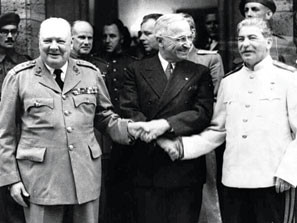On 6 August 1945, the USA unleashed a pivotal event in human history by dropping an atomic bomb on the Japanese city of Hiroshima, forever altering the course of warfare. Three days later, another atomic bomb was deployed over Nagasaki. The aftermath of these devastating explosions resulted in the loss of over 100,000 lives. The primary aim of the USA was to expedite Japan’s surrender, bring an end to World War II, and prevent further casualties among the Allied forces. Additionally, the USA sought to demonstrate the sheer destructive power of its newfound nuclear technology to the world, particularly to the USSR.
During the Potsdam Conference in July 1945, shortly after Truman, the President of the USA, received news of the successful detonation of the world’s first nuclear device during the Trinity Test in the remote region of New Mexico, he communicated with the Soviet Premier, Joseph Stalin. Truman, along with British Prime Minister Winston Churchill (soon to be succeeded by Clement Attlee), formed the “Big Three” to decide the future of Germany after World War II.
At the Conference, Truman casually informed Stalin about the existence of a new weapon possessing extraordinary destructive capabilities. However, Stalin appeared relatively disinterested, expressing his contentment with the news and hoping for its effective use against Japan. In his memoir, A Year of Decisions, Truman recounted this encounter. For Truman, the successful Trinity Test presented a significant decision: whether to employ this world’s first weapon of mass destruction. It also relieved the USA from the necessity of relying on an increasingly hostile USSR to engage in the war against Japan.
Notably, Truman refrained from using the words “atomic” or “nuclear” while communicating with Stalin, and it was assumed that the Soviet leader remained unaware of the precise nature of this new weapon. However, in reality, Soviet intelligence had already learned about the US nuclear development programme as early as September 1941. Despite not viewing the nuclear threat with the same gravity as some of his spies due to the pressing issues posed by the German invasion and occupation, Stalin’s reaction to Truman’s words in Potsdam was pivotal. Upon hearing the news, he promptly instructed his subordinates to accelerate their efforts, with the physicist Igor Kurchatov leading the Soviet atomic bomb project, analogous to J. Robert Oppenheimer’s role in the Manhattan Project.
On 6 August 1945, shortly after the conclusion of the Potsdam Conference, the American aircraft Enola Gay carried out a momentous mission, releasing the uranium bomb codenamed “Little Boy” over the city of Hiroshima, Japan. This action had profound and devastating consequences. Contrary to the USA’s expectations, Japan did not immediately surrender unconditionally. Subsequently, on August 8, Soviet forces launched an invasion of Japanese-occupied Manchuria, which violated a previously agreed non-aggression pact with Japan. Harkin contends that the Soviet offensive would have had an impact on Japanese morale comparable to that of the initial atomic bomb. He explains, “The Japanese government’s last hope, the peace faction, relied on the Soviet Union to mediate peace negotiations with the United States as a neutral intermediary. However, the invasion of Manchuria by the Soviet Union dashed this hope definitively.”
By 1949, any prospects of cooperation had evaporated. On August 29, the USSR successfully conducted its own nuclear test, causing a 20-kiloton explosion, similar in magnitude to the Trinity test. The commencement of the nuclear arms race, which would define the remainder of the Cold War, had commenced, as both superpowers vied to amass the largest arsenal of weapons of mass destruction and develop effective deployment strategies. As Craig asserted, “The existence of the bomb made the United States and the Soviet Union more interdependent than they would have been if it hadn’t existed.”
On August 9, the USA deployed the “Fat Man” plutonium bomb on the city of Nagasaki. The combined destructive force of these two bombs caused the deaths of over 300,000 people, including both immediate casualties and those who succumbed later to radiation exposure and other lasting effects of the explosions. After that, Emperor Hirohito announced Japan’s unconditional surrender through a radio address on August 15, effectively bringing an end to World War II.
The peace discussions at Yalta, like those at Potsdam, highlighted the deepening ideological divide between the USSR and its Western allies, particularly concerning the fate of Eastern Europe. Even to this day, historians continue to debate the motivation behind the Truman Administration’s decision to employ atomic weapons. Some argue that it may have been influenced by political considerations, such as attempting to intimidate the USA, rather than solely for military purposes. As Professor Campbell-Craig, an expert in International Relations at Cardiff University School of Law and Politics and co-author of The Atomic Bomb and the Origins of the Cold War, points out, the secretive nature of the bomb’s development led to a lack of formal discussions and a multitude of interpretations on the subject. Regardless of the intentions behind the bombings of Hiroshima and Nagasaki, Stalin perceived the US possession of atomic weapons as a direct threat to the USSR and its position in the postwar global order. Consequently, he sought to achieve a balance of power. Concurrently, through nuclear espionage, Soviet scientists made significant progress towards developing their own atomic bomb.
In The Truman Administration, there were proponents of cooperation with the USSR, viewing it as the sole means to avert a nuclear arms race. However, as early as 1946, an opposing perspective articulated by George Cannon, an official in the State Department, in his renowned “Long Telegram,” significantly influenced the formulation of the Truman Doctrine and the policy of “containment” toward Soviet and communist expansionism worldwide, deeming it a more effective approach. Subsequently, in 1946, during the inaugural gathering of the United Nations Atomic Energy Commission (UNAEC), the USA introduced the Baruch Plan. This plan called upon the USSR to divulge comprehensive details of its nuclear energy programme and subject its facilities to international inspections before receiving any information or assistance from the USAS.
Predictably, the USSR rejected these conditions. The Baruch Plan essentially compelled the USSR to relinquish some of its sovereignty in exchange for a partial involvement in nuclear power,” as noted by Herkin. “Stalin was absolutely averse to such concessions.”
By 1949, any prospects of cooperation had evaporated. On August 29, the USSR successfully conducted its own nuclear test, causing a 20-kiloton explosion, similar in magnitude to the Trinity test. The commencement of the nuclear arms race, which would define the remainder of the Cold War, had commenced, as both superpowers vied to amass the largest arsenal of weapons of mass destruction and develop effective deployment strategies. As Craig asserted, “The existence of the bomb made the United States and the Soviet Union more interdependent than they would have been if it hadn’t existed.”























